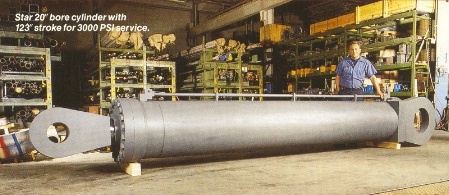The Simple Design of Hydraulic Cylinders
By Jenny Knodell, IQS Editor

Do you ever wonder how those heavy duty, high powered equipment vehicles work? I’m talking about tractors, bulldozers, cranes and trucks that lift, push, haul, dump, dig, crush and drill in countless large-scale applications. They harness enormous power to handle extremely heavy loads. You might be surprised, but the main part behind the power—hydraulic cylinders—are probably more simple than they seem, and they don’t require a lot of energy. They use the basic principle of fluid under pressure, and are featured in any system that needs multiple moving parts at once. These cylinders have been around for a while, since the 1970s, and haven’t changed much in design or function. Sure, their manufacturing processes are faster and the tolerances are tighter, but their classic construction still operates just as well with newer machinery as they do with old.
Hydraulic cylinders are composed of 4 main parts—the outside casing, which is called a barrel and usually made of stainless steel, a piston, rod, gland and butt. The piston rotates and is located on the interior of the cylinder, and the larger its diameter, or bore, the more power it can harness. The piston is an integral part of the hydraulic system because it gives the cylinder force. It’s attached to a rod, which is a long, strong piece of steel that is exposed to the fluid path, and therefore must be exceptionally corrosion resistant. It extends and retracts through the gland, which is the front part of the cylinder. Finally, the butt is located at the base or end of the cylinder, and it is usually the part that attaches to other hydraulic system components, which include pumps, valves and motors.

The oil is held in a reservoir, and when the system is active, it is shot through the cylinder under great pressure. The pressure forces the rod to move back and forth in a linear motion, and because the rod is attached to the piston, it begins to move. Whatever machinery part that is powered by the cylinder is attached to the piston, and thus also moves. So movement starts with the liquid, and is transferred to the rod, then the piston, and then the vehicle or moving part itself.
There are 2 main types of hydraulic cylinders used today—welded body and tie rod. Tie rod hydraulic cylinders have the rods that are attached at both ends of the cylinder. They are more powerful, and are therefore used in heavy-duty industrial machinery requiring more strength. A welded hydraulic cylinder has no rod. Instead, it is attached directly to the object that needs to move. Because it is missing a large component, welded boyd cylinders tend to be much smaller and used in construction equipment like cranes and bulldozers. Newer and different cylinder designs, like telescopic cylinders, which use multiple pistons, offer higher flexibility and a broader range of applications. These new versions, however, still follow the same basic principle as the classic cylinder design.


 Castings & Forgings
Castings & Forgings Bulk Material Handling
Bulk Material Handling Electrical & Electronic Components
Electrical & Electronic Components Flow Instrumentation
Flow Instrumentation Hardware
Hardware Material Handling Equipment
Material Handling Equipment Metal Cutting Services
Metal Cutting Services Metal Forming Services
Metal Forming Services Metal Suppliers
Metal Suppliers Motion Control Products
Motion Control Products Plant & Facility Equipment
Plant & Facility Equipment Plant & Facility Supplies
Plant & Facility Supplies Plastic Molding Processes
Plastic Molding Processes Pumps & Valves
Pumps & Valves Recycling Equipment
Recycling Equipment Rubber Products & Services
Rubber Products & Services